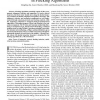40 search results - page 8 / 8 » Abstraction and control for groups of fully-actuated planar ... |
ROMAN
2007
IEEE
13 years 11 months ago
2007
IEEE
Abstract— In this paper we provide a possible characterisation of user behaviour based on an analysis of a corpus of human-robot communication, collected by using the Wizard-of-O...
GECCO
2009
Springer
13 years 12 months ago
2009
Springer
Problems such as the design of distributed controllers are characterized by modularity and symmetry. However, the symmetries useful for solving them are often difficult to determ...
AROBOTS
2008
13 years 3 months ago
2008
Abstract Many elderly and physically impaired people experience difficulties when maneuvering a powered wheelchair. In order to provide improved maneuvering, powered wheelchairs ha...
ICRA
2006
IEEE
13 years 11 months ago
2006
IEEE
Abstract— The roller racer, an undulatory locomotion system, is a toy which can be propelled forward by sitting on it and only oscillating the steering handle. A nonholonomic dyn...
TFS
2008
13 years 5 months ago
2008
Abstract--Flocking algorithms essentially consist of three components: alignment, cohesion, and separation. To track a desired trajectory, the flock center should move along the de...

